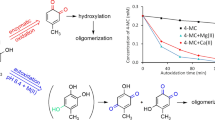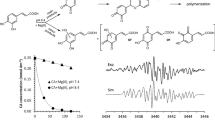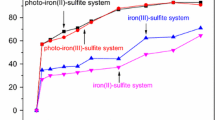Abstract
High performance liquid chromatography with diode array detection (HPLC-DAD) and electron spin resonance (ESR) spectroscopy were used to study Mg(II) ion influence on the autoxidation of catechol in weakly alkaline solution. The presence of Mg(II) ions greatly enhanced the catechol autoxidation rate and probably influenced the mechanism of reaction thus enabling formation of reaction products not obtained in the absence of metal ions. Consecutive formation of 1,2-benzoquinone, 2,3-oxanthrenediol, and 2,3-oxanthrenedione with intermediate o-semiquinone anion radicals during the initial stages of catechol autoxidation was suggested based on the detailed analysis of experimental HPLC-DAD and ESR data. The results of this study may help in better understanding of autoxidation of some biologically important catecholic molecules in real systems, where Mg(II) ions are ubiquitously present. Because of the possible toxicity of simple quinone molecules, it is important that the formation of relatively stable quinoid autoxidation products were detected in this study.
Similar content being viewed by others
Avoid common mistakes on your manuscript.
INTRODUCTION
Catechol (1,2-benzenediol) autoxidation is an interesting research subject because catechol moiety is found widely in many plant polyphenolic antioxidants [1] and drugs [2] whose biological activities are tightly connected with its ease of oxidation and autoxidation. Autoxidation of catechol(s) was also recently investigated in connection with the design of wet adhesive materials [3].
Literature data from many studies revealed that the most important factors influencing catechol(s) autoxidation are pH value [3, 4] and the presence of metal ions [5–9]. Catechol autoxidation rate is greatly enhanced at higher pH values [3] and in the presence of redox active transition metal ions at very low (catalytic) concentrations [5]. As opposed to transition metal ions, alkaline earth ions, like Mg(II), exert this effect at much higher concentrations [7, 8] but their influence may be very important due to their ubiquitous presence in the environment and all biological systems. Indeed, the results of one recent study suggest that human body antioxidant defenses may be partially modulated by magnesium status as a result of Mg(II) ion ability to stabilize cell membranes and oxidation targets, such as adrenaline (a typical example of biologically important catecholic molecule) [10].
Up to date, most studies of catechol autoxidation in the presence of metal ions were concerned with the reaction kinetics and less attention has been paid to the nature of reaction products [5, 8]. In this study we applied high performance liquid chromatography with diode-array detection (HPLC-DAD) and electron spin resonance (ESR) spectroscopy to study the influence of Mg(II) ions on catechol autoxidation in weakly alkaline aqueous solution with the emphasis on structure determination of initial reaction products.
EXPERIMENTAL
All the chemicals used in this study were of analytical (p.a.) grade, except acetonitrile which was of HPLC grade quality. Catechol (CAT) and trifluoroacetic acid were purchased from Merck (Germany). Deionized water was obtained by using TKA Smart2Pure water purification system (Thermo Scientific, Germany).
Working solutions of CAT (0.5 mmol dm–3) were prepared just before the use by diluting CAT stock solution (10 mmol dm–3) obtained by dissolving exactly weighted amount of CAT in 0.1 mol dm–3 solution of HCl. Autoxidation of CAT was initiated by mixing equal volumes of CAT solution and Tris buffer (100 mmol dm–3, pH 8.4) without salt addition or with the addition of MgCl2 (0.2 mol dm–3). Reaction mixtures were kept at room temperature (22 ± 1°C) exposed to air during the experiments.
HPLC analyses were performed on an Agilent Technologies (USA) 1200 Series system equipped with a vacuum degasser, binary pump, temperature controlled column chamber, autosampler, and a diode-array detector (DAD). Separation was achieved at 30°C by using Purospher STAR RP-18e column (150 × 4.6 mm, 5 μm, Merck, Germany). Gradient elution was employed with 0.1% aqueous trifluoroacetic acid (mobile phase A) and acetonitrile (mobile phase B). The gradient of B was established as follows: 0–12 min from 10 to 40%, 12–15 min from 40 to 80%, 15–16 min holding 80%, and 16–20 min from 80 to 100%. The flow rate was 0.5 mL/min, and the injection volume was 10 μL. The chromatograms were recorded in regular 30 min time intervals at detection wavelengths of 220, 275, and 320 nm.
ESR spectra were recorded at room temperature on an X-band Bruker ESR-300E spectrometer (Bruker, Germany) by using quartz flat cell for aqueous samples. The main ESR settings were as follows: microwave frequency—9.64 GHz, microwave power—2.0 mW, modulation frequency—100 kHz, and modulation amplitude—0.1 G. Manipulation and computer simulation of ESR spectra were performed by using epr.exe and simepr.exe DOS programs downloaded from the Web site of the National Institute of Environmental Health Sciences, USA (https://www.niehs.nih.gov/research/resources/software/).
RESULTS AND DISCUSSION
Chromatograms of reaction mixtures obtained after 90 min of catechol autoxidation at pH 8.4 in the absence and presence of Mg(II) ions are shown in Fig. 1.
The most prominent chromatographic peak in both systems at retention time (RT) of 15.6 min belongs to catechol. It is evident that catechol peak area is much smaller in CAT-Mg(II) system in comparison to the system where catechol autoxidation was performed in the absence of metal ions (CAT) which indicates enhanced catechol autoxidation rate in the presence of Mg(II) ions.
The dependence of relative catechol HPLC peak area on autoxidation time is given in Fig. 2.
While only about 2% of catechol is consumed during 90 min of autoxidation in the absence of metal ions, almost 40% of catechol is consumed in the same time in the presence of Mg(II) ions. Similar enhancement of autoxidation rates by the presence of Mg(II) and Ca(II) ions in weakly alkaline aqueous solutions has been already reported for some catecholic plant antioxidants [11–13]. Observed pattern of catechol consumption is very similar to the patterns of oxygen consumption during the autoxidation of catechol and two catecholic drug molecules (dopamine and isoproterenol) in weakly alkaline aqueous solutions in the presence of an excess of alkaline earth metal ions [8]. Data from cited study clearly indicate that enhanced autoxidation rate of catecholic molecules is principally caused by the lowering of their pK values in the presence of alkaline earth metal ions.
In the chromatograms shown in Fig. 1 two common chromatographic peaks with RT values of 6.2 and 14.1 min appear and they obviously originate from the initial autoxidation products of catechol. Since reversed-phase chromatographic separation was employed, lower RT values in comparison to catechol (RT 15.6 min) indicate that these compounds are more polar than catechol. Both common chromatographic peaks appeared in the chromatograms recorded 30 min after catechol autoxidation was initiated. However, while the intensity of these chromatographic peaks steadily increased during the 90 min of catechol autoxidation in the CAT system, the intensity of peak with RT 6.2 min decreased and that for the peak with RT 14.1 min increased in the CAT-Mg(II) system.
Beside these two common chromatographic peaks, the chromatogram of CAT-Mg(II) system contains additional chromatographic peaks at RT values of 10.8, 13.8, and 16.8 min, not present in the chromatogram of CAT system. Straightforward explanation for the appearance of these additional chromatographic peaks would be the formation of further catechol autoxidation products in the CAT-Mg(II) system due to the higher reaction rate. However, two of the additional chromatographic peaks in CAT-Mg(II) system have RT values lower than catechol (15.6 min) while prolonged catechol autoxidation is expected to produce oligomeric and/or polymeric products with higher RT values in comparison to catechol. Therefore, it is highly probable that the presence of Mg(II) ions also influences the mechanism of reaction and causes the formation of different reaction products not obtained in the absence of Mg(II) ions.
DAD UV–Vis spectra of catechol and two compounds present in both investigated systems (at RT of 6.2 and 14.1 min) are shown in Fig. 3.
Noticeable absorbance of two common autoxidation products with RT of 6.2 and 14.1 min above 400 nm is probably the consequence of increased electron delocalization which may be indicative for the formation of quinoid compounds during catechol autoxidation [7, 14].
Autoxidation reactions of 1,2-benzenediols in alkaline aqueous solutions are generally known to involve free radical species which can be detected by ESR spectroscopy [15] and the first step in catechol autoxidation is expected to be the formation of its o‑semiquinone anion radical. However, attempts to record useful ESR spectra of solutions where catechol autoxidation at pH 8.4 was performed in the absence of Mg(II) ions were not successful. This lack of ESR signal was perhaps the consequence of low concentration and/or high reactivity of free radicals formed which make them virtually undetectable by static ESR method used in this study.
We succeeded to obtain good quality ESR spectra for aqueous solution where catechol autoxidation at pH 8.4 was performed in the presence of Mg(II) ions at different time intervals from the start of reaction as a result of the so called spin-stabilization effect [16, 17]. ESR spectrum recorded after 5 min of catechol autoxidation at pH 8.4 in the presence of Mg(II) ions and its computer simulation are shown in Fig. 4.
Asymmetrical appearance of experimental ESR spectrum indicates simultaneous presence of at least two different radical species at the early stage of catechol autoxidation in the presence of Mg(II) ions. The primary radical formed was obviously Mg(II) ion spin-stabilized o-benzosemiquinone anion radical since its ESR spectrum is characterized by triplet of triplets with 1 : 2 : 1 signal intensity ratios originating from two pairs of two equivalent protons in its structure [16, 17]. Also, measured hyperfine coupling constant values (3.925 and 0.520 G) are in excellent agreement with the literature data for this radical [17]. Good computer simulation (correlation 0.9903) of experimental ESR spectrum shown in Fig. 4 was obtained by assuming simultaneous existence of two radical species, one of them being the primary Mg(II) ion spin-stabilized o-benzosemiquinone anion radical. For the secondary radical the structure containing three groups of two equivalent protons with hyperfine coupling constant values of 2.715, 0.505, and 0.270 G was assumed. Based on this assumption, this secondary radical may be the Mg(II) ion spin-stabilized o‑semiquinone anion radical obtained by the one electron oxidation of 2,3-oxanthrenediole (dibenzo[b,e][1,4]dioxin-2,3-diol), a catechol dimer whose quinone formation during catechol oxidation/autoxidation under various conditions was already reported in the literature [18–21]. Calculated g-value of 2.0039 for the secondary radical is lower than the g-value of Mg(II) ion spin-stabilized o-benzosemiquinone anion radical (2.0042 [17]) thus indicating increased unpaired electron delocalization in comparison to the primary radical which is in agreement with its proposed structure. ESR spectra recorded during the catechol autoxidation up to the 105 min of reaction have similar appearance to the spectrum shown in Fig. 4 with gradually increased signal intensity of secondary radical and lower signal-to-noise ratio, especially in the central part of the spectra, which may be indicative for the presence of small concentrations of some additional free radical(s).
Based on the analysis of experimental results obtained by the HPLC-DAD and ESR spectroscopy we propose the order of initial reactions during the catechol autoxidation in weakly alkaline aqueous solutions shown in Fig. 5.
Successive formation of 1,2-benzoquinone, 2,3-oxanthrenediol, and 2,3-oxanthrenedione with intermediate o-semiquinone anion radicals is proposed during the initial stages of catechol autoxidation. Two quinones, 1,2-benzoquinone and 2,3-oxanthrenedione, are compounds with RT values of 6.2 and 14.1 min, respectively, in chromatograms shown in Fig. 1. Calculated ACD/LogP values (data taken from www.chemspider.com) for 1,2-benzoquinone (‒0.60) and 2,3-oxanthrenedione (0.63) indicate that these compounds are more polar than catechol (0.88) and this is in agreement with the order of their RT values in reversed-phase HPLC system used in this study. As for the 2,3-oxanthrenediol formed in the reaction between 1,2-benzoquinone and catechol, calculated ACD/logP value (3.16) points toward much higher RT value in comparison to catechol and such compound was not detected in chromatograms shown in Fig. 1. However, the characterization of Mg(II) ion spin-stabilized secondary radical detected by ESR spectroscopy can be taken as evidence for the formation of 2,3-oxanthrenediol because only its one electron oxidation can give such a radical in this system.
CONCLUSIONS
Autoxidation of catechol in weakly alkaline solution in the absence and in the presence of Mg(II) ions was studied by using high performance liquid chromatography with diode array detection (HPLC-DAD) and electron spin resonance (ESR) spectroscopy. The presence of Mg(II) ions greatly enhanced the catechol autoxidation rate and possibly influenced the mechanism of reaction by enabling formation of reaction products not obtained in the absence of metal ions. Detailed analysis of experimental HPLC-DAD and ESR data indicated that successive formation of 1,2‑benzoquinone, 2,3-oxanthrenediol, and 2,3-oxanthrenedione with intermediate o-semiquinone anion radicals occurred during the initial stages of catechol autoxidation. The results of this study may help in better understanding of autoxidation of some biologically important catecholic molecules in real systems with ubiquitous presence of Mg(II) ions. Additional point to note is the formation of relatively stable quinoid autoxidation products, which may be very important if we consider the reactivity and possible toxicity of simple quinone molecules [22, 23].
REFERENCES
S. Quideau, D. Deffieux, C. Douat-Casassus, and L. Pouységu, Angew. Chem. Int. Ed. 50, 586 (2011).
D. P. Yang, H. F. Ji, G. Y. Tang, W. Ren, and H. Y. Zhang, Molecules 12, 578 (2007).
G. P. Maier, C. M. Bernt, and A. Butler, Biomater. Sci. 6, 332 (2018).
M. Friedman and H. S. Jürgens, J. Agric. Food Chem. 48, 2101 (2000).
J. Balla, T. Kiss, and R. F. Jameson, Inorg. Chem. 31, 58 (1992).
P. García, C. Romero, M. Brenes, and A. Garrido, J. Agric. Food Chem. 44, 2101 (1996).
G. M. Nikolić, P. I. Premović, and R. S. Nikolić, Spectrosc. Lett. 31, 327 (1998).
A. V. Lebedev, M. V. Ivanova, A. A. Timoshin, and E. K. Ruuge, ChemPhysChem 8, 1863 (2007).
E. Nikhili, M. Loonis, S. Mihai, H. El Hajji, and O. Dangles, Food Funct. 5, 1186 (2014).
C. P. Monteiro, C. N. Matias, M. Bicho, H. Santa-Clara, and M. J. Laires, Magnes. Res. 29, 161 (2016).
S. C. Živanović, R. S. Nikolić, and G. M. Nikolić, Acta Fac. Med. Naiss. 33, 163 (2016).
S. C. Živanovic, R. S. Nikolić, D. A. Kostic, and G. M. Nikolić, Oxid. Commun. 40, 581 (2017).
S. C. Živanović, A. M. Veselinović, Ž. J. Mitić, and G. M. Nikolić, New J. Chem. 42, 6256 (2018).
L. V. Volod’ko, A. I. Komyak, A. A. Min’ko, B. A. Tatarinov, and P. A. Matusevich, J. Appl. Spectrosc. 24, 717 (1976).
R. Hoskins, J. Chem. Phys. 23, 1975 (1955).
D. R. Eaton, Inorg. Chem. 3, 1268 (1964).
C. C. Felix and R. C. Sealy, J. Am. Chem. Soc. 104, 1555 (1982).
W. G. C. Forsyth, V. C. Quesnel, and J. B. Roberts, Biochim. Biophys. Acta 37, 322 (1960).
M. B. McBride and F. J. Sikora, J. Inorg. Biochem. 39, 247 (1990).
A. Naidja, P. M. Huang, and J.-M. Bollag, Soil Sci. Soc. Am. J. 62, 188 (1998).
F. Solano, New J. Sci. 2014, 498276 (2014).
J. L. Bolton and T. Dunlap, Chem. Res. Toxicol. 30, 13 (2017).
T. M. Penning, Toxicol. Res. 6, 740 (2017).
ACKNOWLEDGMENTS
This work was partially supported by the Ministry for Science and Technological Development of the Republic of Serbia (grant no. 172044).
Author information
Authors and Affiliations
Corresponding author
Rights and permissions
About this article
Cite this article
Nikolić, G.M., Živanović, S.C., Krstić, N.S. et al. The Study of Mg(II) Ion Influence on Catechol Autoxidation in Weakly Alkaline Aqueous Solution. Russ. J. Phys. Chem. 93, 2656–2660 (2019). https://doi.org/10.1134/S0036024419130223
Received:
Revised:
Accepted:
Published:
Issue Date:
DOI: https://doi.org/10.1134/S0036024419130223









